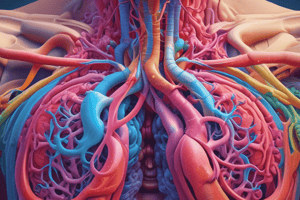Podcast
Questions and Answers
What is the primary function of the respiratory system?
What is the primary function of the respiratory system?
- To exchange gases between the environment and the body's cells (correct)
- To regulate blood pressure
- To produce energy for the body
- To digest food
Which of the following is NOT a step in the process of gas exchange in the respiratory system?
Which of the following is NOT a step in the process of gas exchange in the respiratory system?
- Lungs to blood
- Cells of the body to blood to liver (correct)
- Environment to lungs
- Blood to cells of the body
What is the role of cellular respiration in the body?
What is the role of cellular respiration in the body?
- To produce new cells for the body
- To remove waste products from the body
- To regulate blood sugar levels
- To convert glucose into energy in the form of ATP (correct)
What is the difference between aerobic and anaerobic respiration?
What is the difference between aerobic and anaerobic respiration?
What is the purpose of the glycolysis process in cellular respiration?
What is the purpose of the glycolysis process in cellular respiration?
What is the role of ATP, ADP, NADH, and FAD in cellular respiration?
What is the role of ATP, ADP, NADH, and FAD in cellular respiration?
What is the starting molecule for the glycolysis process?
What is the starting molecule for the glycolysis process?
What is the first step in the glycolysis process?
What is the first step in the glycolysis process?
What is the final product of the glycolysis process?
What is the final product of the glycolysis process?
What is the purpose of the gas exchange process between the environment and the lungs?
What is the purpose of the gas exchange process between the environment and the lungs?
What is the primary energy currency molecule produced during cellular respiration?
What is the primary energy currency molecule produced during cellular respiration?
What is the role of NADH and FAD in cellular respiration?
What is the role of NADH and FAD in cellular respiration?
What is the difference between aerobic and anaerobic respiration?
What is the difference between aerobic and anaerobic respiration?
What is the role of the respiratory system in cellular respiration?
What is the role of the respiratory system in cellular respiration?
What is the purpose of the gas exchange process between the lungs and the blood?
What is the purpose of the gas exchange process between the lungs and the blood?
What is the role of the digestive system in cellular respiration?
What is the role of the digestive system in cellular respiration?
Flashcards are hidden until you start studying
Study Notes
Respiratory System
- Deals with gases or exchange of gases
- Two main gases involved: Oxygen (O2) - needed, Carbon Dioxide (CO2) - waste
Gas Exchange Process
- Environment (O2) → Lungs → Blood → Cells of the Body → CO2 → Collected by Blood → Lungs → Environment (CO2)
Cellular Respiration
- Yields energy in the form of ATP (Adenosine Triphosphate)
- Energy production: C6H12O6 + O2 = ATP, CO2, H2O
- Glucose comes from Carbohydrates processed by the Digestive system, specifically from Small Intestine
Cellular Respiration Terms
- ATP (Adenosine Triphosphate)
- ADP (Adenosine Diphosphate)
- NADH (Nicotinamide Adenine Dinucleotide)
- FAD (Flavin Adenine Dinucleotide)
- DHAP (Dihydroxy Acetone Phosphate)
- GAP (Glyceraldehyde Triphosphate)
- Fructose 1-6 Biphosphate
Aerobic vs Anaerobic
- Aerobic: needs oxygen for cellular respiration
- Anaerobic: no oxygen needed, uses fermentation
Glycolysis
- Step 1: 2 phosphates from 2 ATPs are removed and become ADP
- Step 2: phosphates attach to 6 Carbon atoms of Glucose, converting it to Fructose 1-6 Biphosphate
- Step 3: Fructose 1-6 Biphosphate divides into DHAP and GAP
Studying That Suits You
Use AI to generate personalized quizzes and flashcards to suit your learning preferences.




